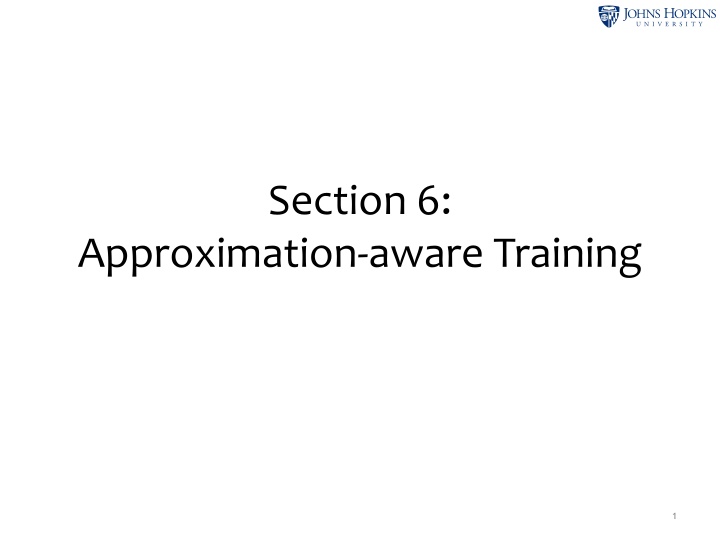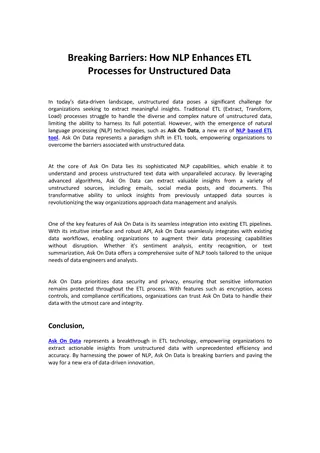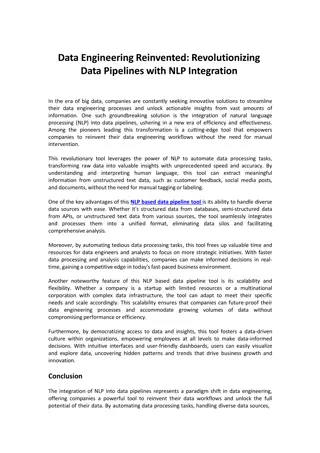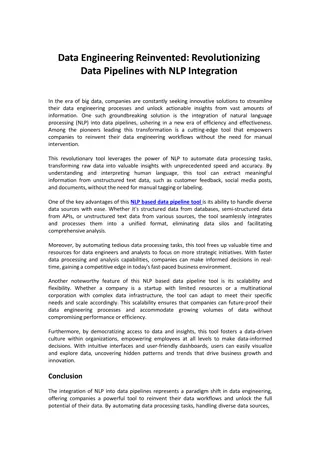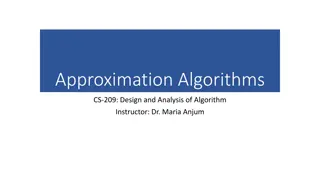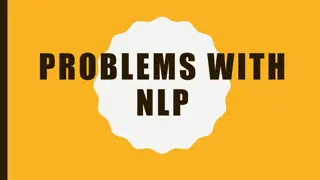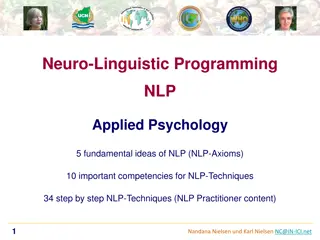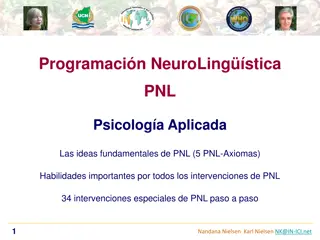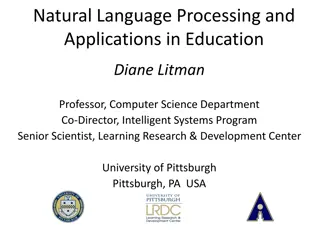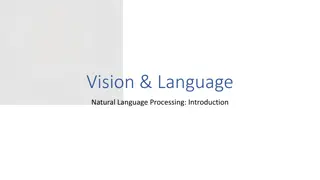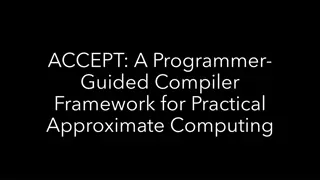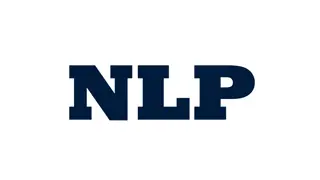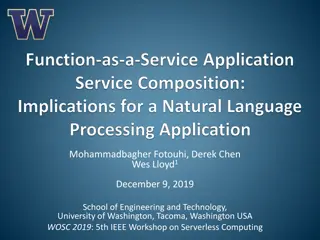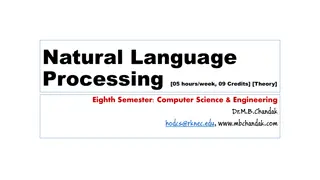Advanced NLP Modeling Techniques: Approximation-aware Training
Push beyond traditional NLP models like logistic regression and PCFG with approximation-aware training. Explore factor graphs, BP algorithm, and fancier models to improve predictions. Learn how to tweak algorithms, tune parameters, and build custom models for machine learning in NLP.
Download Presentation

Please find below an Image/Link to download the presentation.
The content on the website is provided AS IS for your information and personal use only. It may not be sold, licensed, or shared on other websites without obtaining consent from the author.If you encounter any issues during the download, it is possible that the publisher has removed the file from their server.
You are allowed to download the files provided on this website for personal or commercial use, subject to the condition that they are used lawfully. All files are the property of their respective owners.
The content on the website is provided AS IS for your information and personal use only. It may not be sold, licensed, or shared on other websites without obtaining consent from the author.
E N D
Presentation Transcript
Section 6: Approximation-aware Training 1
Outline Do you want to push past the simple NLP models (logistic regression, PCFG, etc.) that we've all been using for 20 years? Then this tutorial is extremely practical for you! 1. Models: Factor graphs can express interactions among linguistic structures. 2. Algorithm: BP estimates the global effect of these interactions on each variable, using local computations. 3. Intuitions: What s going on here? Can we trust BP s estimates? 4. Fancier Models: Hide a whole grammar and dynamic programming algorithm within a single factor. BP coordinates multiple factors. 5. Tweaked Algorithm: Finish in fewer steps and make the steps faster. 6. Learning: Tune the parameters. Approximately improve the true predictions -- or truly improve the approximate predictions. 7. Software: Build the model you want! 2
Outline Do you want to push past the simple NLP models (logistic regression, PCFG, etc.) that we've all been using for 20 years? Then this tutorial is extremely practical for you! 1. Models: Factor graphs can express interactions among linguistic structures. 2. Algorithm: BP estimates the global effect of these interactions on each variable, using local computations. 3. Intuitions: What s going on here? Can we trust BP s estimates? 4. Fancier Models: Hide a whole grammar and dynamic programming algorithm within a single factor. BP coordinates multiple factors. 5. Tweaked Algorithm: Finish in fewer steps and make the steps faster. 6. Learning: Tune the parameters. Approximately improve the true predictions -- or truly improve the approximate predictions. 7. Software: Build the model you want! 3
Modern NLP Linguistics Mathematical Modeling NLP Machine Learning Combinatorial Optimization 4
Machine Learning for NLP Linguistics Linguistics inspires the structures we want to predict No semantic interpretation 5
Machine Learning for NLP Linguistics Mathematical Modeling p ( ) = 0.50 Our model defines a score for each structure p ( ) = 0.25 p ( ) = 0.10 p ( ) = 0.01 6
Machine Learning for NLP Linguistics Mathematical Modeling p ( ) = 0.50 Our model defines a score for each structure p ( ) = 0.25 p ( ) = 0.10 It also tells us what to optimize p ( ) = 0.01 7
Machine Learning for NLP Given training instances{(x1, y1), (x2, y2), , (xn, yn)} Linguistics Mathematical Modeling y1: y2: x1: x2: y3: Machine Learning x3: Find the best model parameters, Learning tunes the parameters of the model 8
Machine Learning for NLP Given training instances{(x1, y1), (x2, y2), , (xn, yn)} Linguistics Mathematical Modeling y1: y2: x1: x2: y3: Machine Learning x3: Find the best model parameters, Learning tunes the parameters of the model 9
Machine Learning for NLP Given training instances{(x1, y1), (x2, y2), , (xn, yn)} Linguistics Mathematical Modeling y1: y2: x1: x2: y3: Machine Learning x3: Find the best model parameters, Learning tunes the parameters of the model 10
Machine Learning for NLP Given a new sentence, xnew Search over the set of all possible structures (often exponential in size of xnew) Return the highest scoring structure, y* Linguistics Mathematical Modeling Machine Learning Combinatorial Optimization Inference finds the best structure for a new sentence y*: y*: xnew: xnew: (Inference is usually called as a subroutine in learning) 11
Machine Learning for NLP Given a new sentence, xnew Search over the set of all possible structures (often exponential in size of xnew) Return the Minimum Bayes Risk (MBR) structure, y* Linguistics Mathematical Modeling Machine Learning Combinatorial Optimization Inference finds the best structure for a new sentence y*: y*: xnew: xnew: (Inference is usually called as a subroutine in learning) 12
Machine Learning for NLP Given a new sentence, xnew Search over the set of all possible structures (often exponential in size of xnew) Return the Minimum Bayes Risk (MBR) structure, y* Linguistics Mathematical Modeling Machine Learning Combinatorial Optimization Inference finds the best structure for a new sentence Polynomial time NP-hard Easy (Inference is usually called as a subroutine in learning) 13 13
Modern NLP Our model defines a score for each structure Linguistics inspires the structures we want to predict It also tells us what to optimize Linguistics Mathematical Modeling NLP Inference finds the best structure for a new sentence Machine Learning Combinatorial Optimization Learning tunes the parameters of the model (Inference is usually called as a subroutine in learning) 14
Mathematical Modeling An Abstraction for Modeling Now we can work at this level of abstraction. 15
Training Thus far, we ve seen how to compute (approximate) marginals, given a factor graph Two ways to learn: 1. Standard CRF Training (very simple; often yields state-of-the- art results) ERMA (less simple; but takes approximations and loss function into account) but where do the potential tables come from? Some have a fixed structure (e.g. Exactly1, CKYTree) Others could be trained ahead of time (e.g. TrigramHMM) For the rest, we define them parametrically and learn the parameters! 2. 16
Standard CRF Parameterization Define each potential function in terms of a fixed set of feature functions: Observed variables Predicted variables 17
Standard CRF Parameterization Define each potential function in terms of a fixed set of feature functions: p n n v d 6 2 4 8 1 3 5 7 9 like arrow time flies an 18
Standard CRF Parameterization Define each potential function in terms of a fixed set of feature functions: s 13 vp 12 pp 11 np 10 p n n v d 6 2 4 8 5 9 1 3 7 19 like flies time an arrow
What is Training? That s easy: Training = picking good model parameters! But how do we know if the model parameters are any good ? 20
LearningConditional Log-likelihood Training Machine 1. Choose model Such that derivative in #3 is ea Choose objective: Assign high probability to the things we observe and low probability to everything else 2. 3. Compute derivative by hand using the chain rule Replace exact inference by approximate inference 4. 21
Conditional Log-likelihood Training Machine Learning 1. Choose model Such that derivative in #3 is easy Choose objective: Assign high probability to the things we observe and low probability to everything else 2. 3. Compute derivative by hand using the chain rule Replace exact inference by approximate inference 4. We can approximate the factor marginals by the (normalized) factor beliefs from BP! 22
Whats wrong with the usual approach? If you add too many factors, your predictions might get worse! The model might be richer, but we replace the true marginals with approximate marginals (e.g. beliefs computed by BP) Approximate inference can cause gradients for structured learning to go awry! (Kulesza & Pereira, 2008). 24
Whats wrong with the usual approach? Mistakes made by Standard CRF Training: 1. Using BP (approximate) 2. Not taking loss function into account 3. Should be doing MBR decoding Big pile of approximations which has tunable parameters. Treat it like a neural net, and run backprop! 25
Modern NLP Our model defines a score for each structure Linguistics inspires the structures we want to predict It also tells us what to optimize Linguistics Mathematical Modeling NLP Inference finds the best structure for a new sentence Machine Learning Combinatorial Optimization Learning tunes the parameters of the model (Inference is usually called as a subroutine in learning) 26
Empirical Risk Minimization 1. Given training data: y1: y2: x1: x2: y3: x3: 2. Choose each of these: Decision function Examples: Linear regression, Logistic regression, Neural Network Loss function Examples: Mean-squared error, Cross Entropy 27
Empirical Risk Minimization 1. Given training data: 3. Define goal: 2. Choose each of these: Decision function 4. Train with SGD: (take small steps opposite the gradient) Loss function 28
Empirical Risk Minimization 1. Given training data: 3. Define goal: 2. Choose each of these: Decision function 4. Train with SGD: (take small steps opposite the gradient) Loss function 29
Conditional Log-likelihood Training Machine Learning 1. Choose model Such that derivative in #3 is easy Choose objective: Assign high probability to the things we observe and low probability to everything else 2. 3. Compute derivative by hand using the chain rule Replace true inference by approximate inference 4. 30
What went wrong? Machine Learning How did we compute these approximate marginal probabilities anyway? By Belief Propagation of course! 31
Error Back-Propagation 32 Slide from (Stoyanov & Eisner, 2012)
Error Back-Propagation 33 Slide from (Stoyanov & Eisner, 2012)
Error Back-Propagation 34 Slide from (Stoyanov & Eisner, 2012)
Error Back-Propagation 35 Slide from (Stoyanov & Eisner, 2012)
Error Back-Propagation 36 Slide from (Stoyanov & Eisner, 2012)
Error Back-Propagation 37 Slide from (Stoyanov & Eisner, 2012)
Error Back-Propagation 38 Slide from (Stoyanov & Eisner, 2012)
Error Back-Propagation 39 Slide from (Stoyanov & Eisner, 2012)
Error Back-Propagation 40 Slide from (Stoyanov & Eisner, 2012)
Error Back-Propagation P(y3=noun|x) (y1 y2)= (y3 y1)* (y4 y1) y3 41 Slide from (Stoyanov & Eisner, 2012)
Error Back-Propagation Applying the chain rule of differentiation over and over. Forward pass: Regular computation (inference + decoding) in the model (+ remember intermediate quantities). Backward pass: Replay the forward pass in reverse, computing gradients. 42
Background: Backprop through time Recurrent neural network: BPTT: 1. Unroll the computation over time y4 yt+1 x4 b3 2. Run backprop through the resulting feed- forward network xt+1 x3 bt b2 x2 a xt b1 x1 a 43
What went wrong? Machine Learning How did we compute these approximate marginal probabilities anyway? By Belief Propagation of course! 44
ERMA Empirical Risk Minimization under Approximations (ERMA) Apply Backprop through time to Loopy BP Unrolls the BP computation graph Includes inference, decoding, loss and all the approximations along the way 45 (Stoyanov, Ropson, & Eisner, 2011)
ERMA Machine Learning Key idea: Open up the black box! 1. Choose model to be the computation with all its approximations Choose objective to likewise include the approximations Compute derivative by backpropagation (treating the entire computation as if it were a neural network) Make no approximations! (Our gradient is exact) 2. 3. 4. 46 (Stoyanov, Ropson, & Eisner, 2011)
ERMA Machine Learning Key idea: Open up the black box! Empirical Risk Minimization Minimum Bayes Risk (MBR) Decoder 47 (Stoyanov, Ropson, & Eisner, 2011)
Approximation-aware Learning Machine Learning Key idea: Open up the black box! What if we re using Structured BP instead of regular BP? No problem, the same approach still applies! The only difference is that we embed dynamic programming algorithms inside our computation graph. 48 (Gormley, Dredze, & Eisner, 2015)
Connection to Deep Learning exp( y f(x)) y P(y|x) ex ef1 efn hfn W gf1 gfn hf1 W ef1,t efn,1 ef1,1 efn,t 49 (Gormley, Yu, & Dredze, In submission)
Empirical Risk Minimization under Approximations (ERMA) Approximation Aware No Yes MLE No SVMstruct [Finley and Joachims, 2008] M3N [Taskar et al., 2003] Softmax-margin [Gimpel & Smith, 2010] ERMA Loss Aware Yes 50 Figure from (Stoyanov & Eisner, 2012)
